Taxation Law Assignment: Income, Deductions, CGT Analysis, UTS
VerifiedAdded on 2023/06/04
|10
|2353
|377
Report
AI Summary
This assignment provides a detailed analysis of taxation law, focusing on assessable income, allowable deductions, and capital gains tax (CGT) implications. It examines various scenarios related to an accountant's income, including salary, bonuses, awards, and business activities. The report applies relevant sections of the ITAA 1936 and ITAA 1997, along with case law, to determine the tax consequences of different income streams and expenses. Key issues addressed include the deductibility of clothing expenses, travel expenses, and the tax treatment of prizes and awards. Furthermore, the assignment explores the CGT implications of selling collectables and the destruction of a rental property, providing a comprehensive overview of the relevant tax principles and their application to real-world scenarios. Desklib offers this and many other solved assignments to aid students in their studies.
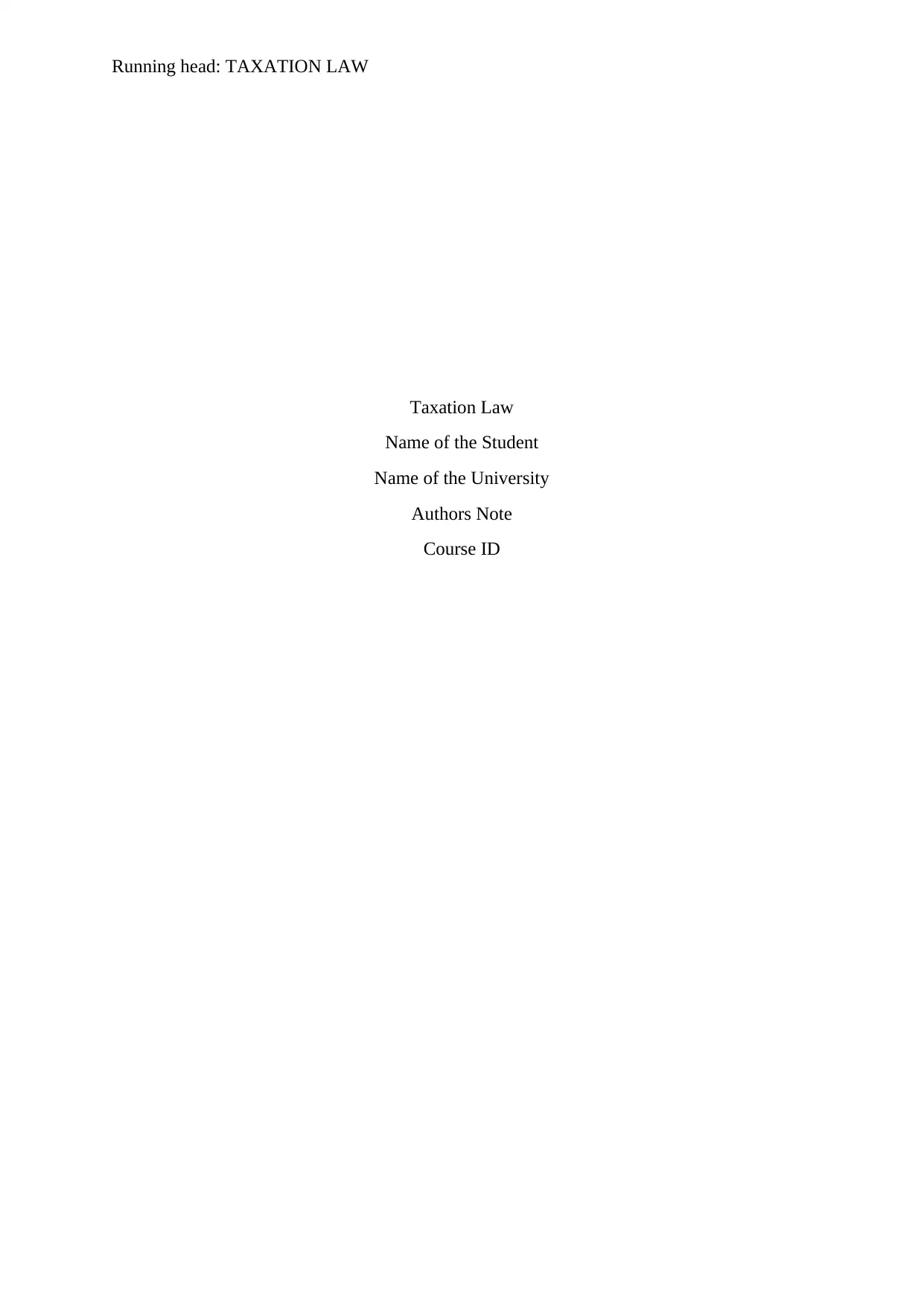
Running head: TAXATION LAW
Taxation Law
Name of the Student
Name of the University
Authors Note
Course ID
Taxation Law
Name of the Student
Name of the University
Authors Note
Course ID
Paraphrase This Document
Need a fresh take? Get an instant paraphrase of this document with our AI Paraphraser
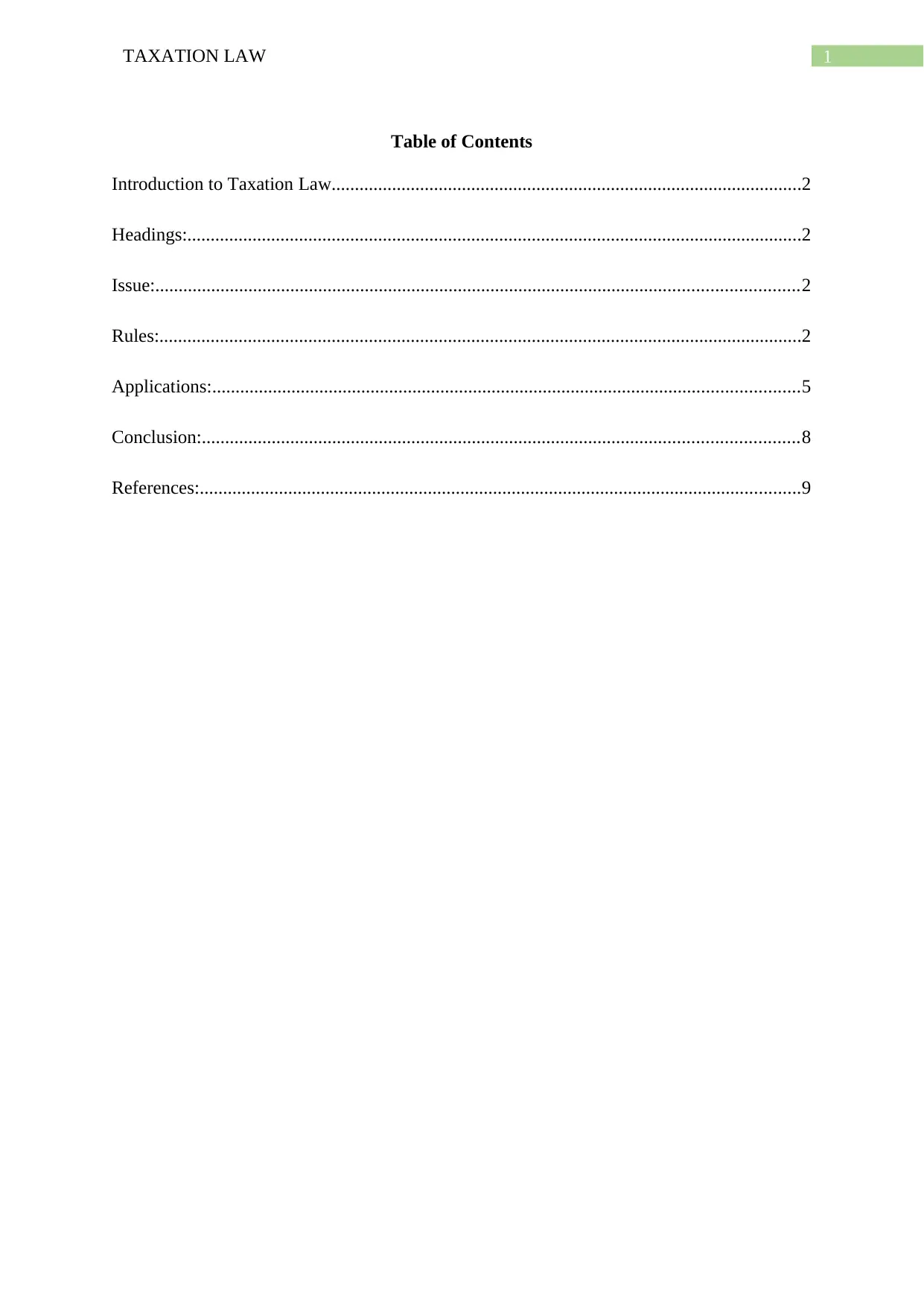
1TAXATION LAW
Table of Contents
Introduction to Taxation Law.....................................................................................................2
Headings:....................................................................................................................................2
Issue:..........................................................................................................................................2
Rules:..........................................................................................................................................2
Applications:..............................................................................................................................5
Conclusion:................................................................................................................................8
References:.................................................................................................................................9
Table of Contents
Introduction to Taxation Law.....................................................................................................2
Headings:....................................................................................................................................2
Issue:..........................................................................................................................................2
Rules:..........................................................................................................................................2
Applications:..............................................................................................................................5
Conclusion:................................................................................................................................8
References:.................................................................................................................................9
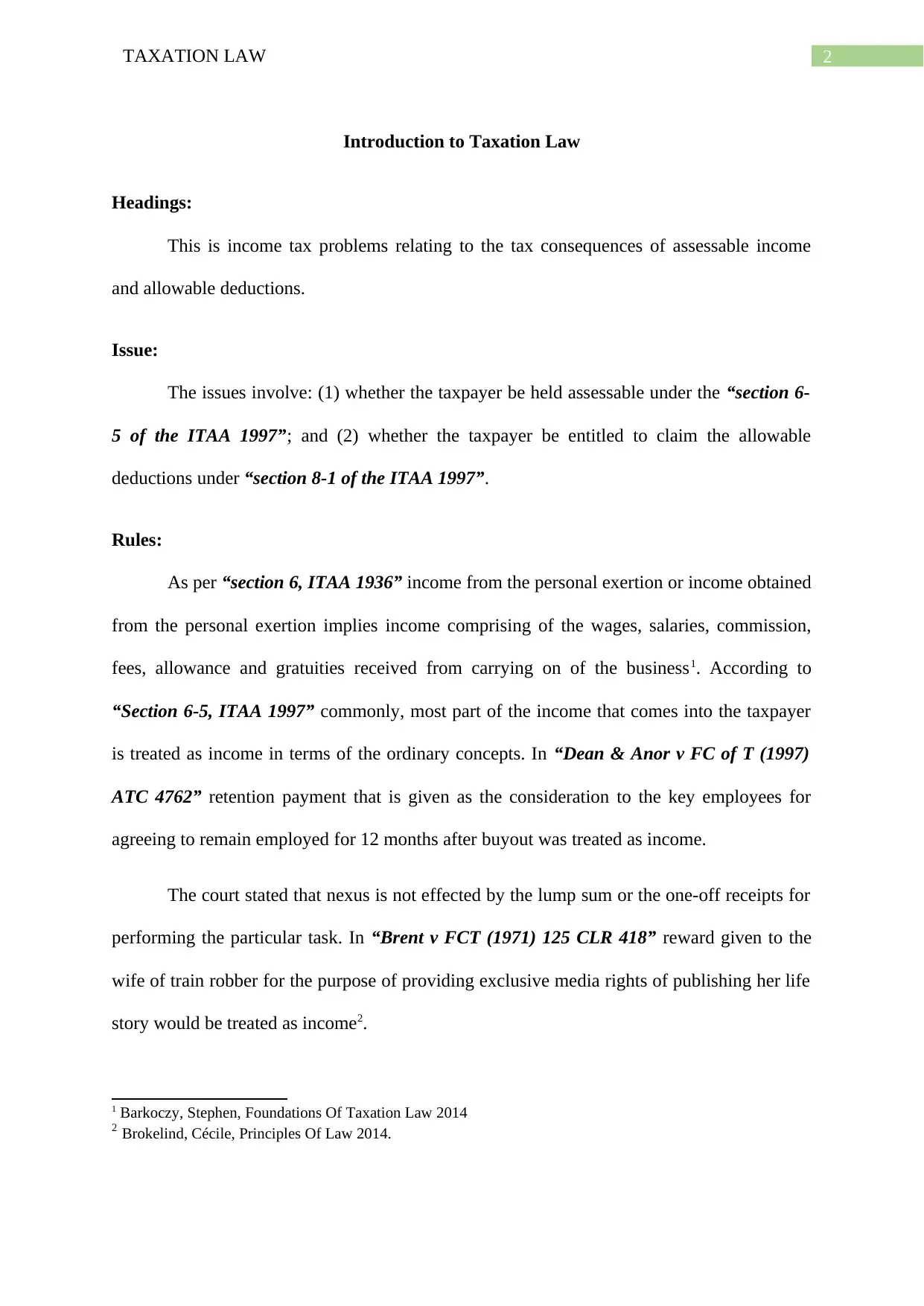
2TAXATION LAW
Introduction to Taxation Law
Headings:
This is income tax problems relating to the tax consequences of assessable income
and allowable deductions.
Issue:
The issues involve: (1) whether the taxpayer be held assessable under the “section 6-
5 of the ITAA 1997”; and (2) whether the taxpayer be entitled to claim the allowable
deductions under “section 8-1 of the ITAA 1997”.
Rules:
As per “section 6, ITAA 1936” income from the personal exertion or income obtained
from the personal exertion implies income comprising of the wages, salaries, commission,
fees, allowance and gratuities received from carrying on of the business1. According to
“Section 6-5, ITAA 1997” commonly, most part of the income that comes into the taxpayer
is treated as income in terms of the ordinary concepts. In “Dean & Anor v FC of T (1997)
ATC 4762” retention payment that is given as the consideration to the key employees for
agreeing to remain employed for 12 months after buyout was treated as income.
The court stated that nexus is not effected by the lump sum or the one-off receipts for
performing the particular task. In “Brent v FCT (1971) 125 CLR 418” reward given to the
wife of train robber for the purpose of providing exclusive media rights of publishing her life
story would be treated as income2.
1 Barkoczy, Stephen, Foundations Of Taxation Law 2014
2 Brokelind, Cécile, Principles Of Law 2014.
Introduction to Taxation Law
Headings:
This is income tax problems relating to the tax consequences of assessable income
and allowable deductions.
Issue:
The issues involve: (1) whether the taxpayer be held assessable under the “section 6-
5 of the ITAA 1997”; and (2) whether the taxpayer be entitled to claim the allowable
deductions under “section 8-1 of the ITAA 1997”.
Rules:
As per “section 6, ITAA 1936” income from the personal exertion or income obtained
from the personal exertion implies income comprising of the wages, salaries, commission,
fees, allowance and gratuities received from carrying on of the business1. According to
“Section 6-5, ITAA 1997” commonly, most part of the income that comes into the taxpayer
is treated as income in terms of the ordinary concepts. In “Dean & Anor v FC of T (1997)
ATC 4762” retention payment that is given as the consideration to the key employees for
agreeing to remain employed for 12 months after buyout was treated as income.
The court stated that nexus is not effected by the lump sum or the one-off receipts for
performing the particular task. In “Brent v FCT (1971) 125 CLR 418” reward given to the
wife of train robber for the purpose of providing exclusive media rights of publishing her life
story would be treated as income2.
1 Barkoczy, Stephen, Foundations Of Taxation Law 2014
2 Brokelind, Cécile, Principles Of Law 2014.
⊘ This is a preview!⊘
Do you want full access?
Subscribe today to unlock all pages.

Trusted by 1+ million students worldwide
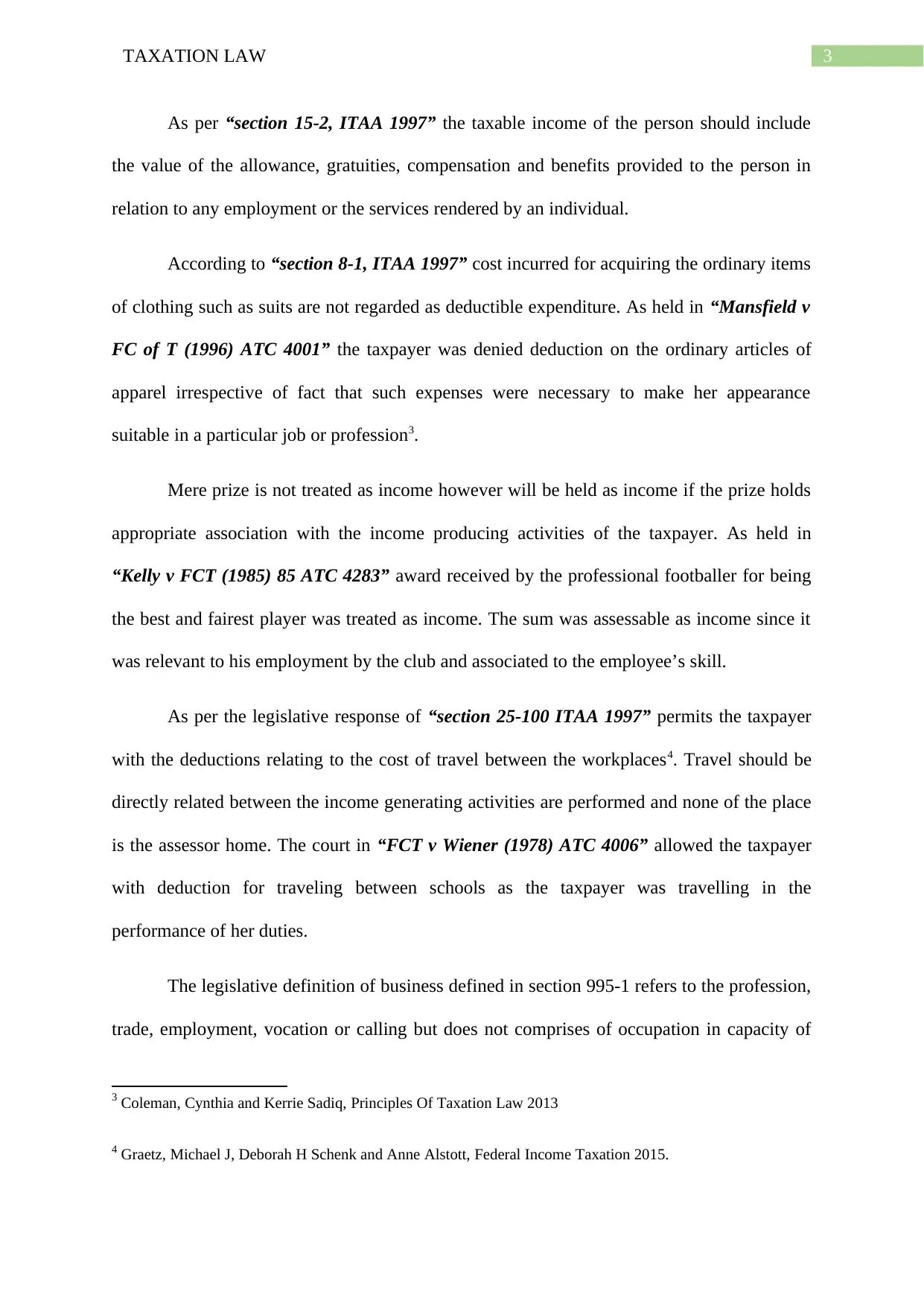
3TAXATION LAW
As per “section 15-2, ITAA 1997” the taxable income of the person should include
the value of the allowance, gratuities, compensation and benefits provided to the person in
relation to any employment or the services rendered by an individual.
According to “section 8-1, ITAA 1997” cost incurred for acquiring the ordinary items
of clothing such as suits are not regarded as deductible expenditure. As held in “Mansfield v
FC of T (1996) ATC 4001” the taxpayer was denied deduction on the ordinary articles of
apparel irrespective of fact that such expenses were necessary to make her appearance
suitable in a particular job or profession3.
Mere prize is not treated as income however will be held as income if the prize holds
appropriate association with the income producing activities of the taxpayer. As held in
“Kelly v FCT (1985) 85 ATC 4283” award received by the professional footballer for being
the best and fairest player was treated as income. The sum was assessable as income since it
was relevant to his employment by the club and associated to the employee’s skill.
As per the legislative response of “section 25-100 ITAA 1997” permits the taxpayer
with the deductions relating to the cost of travel between the workplaces4. Travel should be
directly related between the income generating activities are performed and none of the place
is the assessor home. The court in “FCT v Wiener (1978) ATC 4006” allowed the taxpayer
with deduction for traveling between schools as the taxpayer was travelling in the
performance of her duties.
The legislative definition of business defined in section 995-1 refers to the profession,
trade, employment, vocation or calling but does not comprises of occupation in capacity of
3 Coleman, Cynthia and Kerrie Sadiq, Principles Of Taxation Law 2013
4 Graetz, Michael J, Deborah H Schenk and Anne Alstott, Federal Income Taxation 2015.
As per “section 15-2, ITAA 1997” the taxable income of the person should include
the value of the allowance, gratuities, compensation and benefits provided to the person in
relation to any employment or the services rendered by an individual.
According to “section 8-1, ITAA 1997” cost incurred for acquiring the ordinary items
of clothing such as suits are not regarded as deductible expenditure. As held in “Mansfield v
FC of T (1996) ATC 4001” the taxpayer was denied deduction on the ordinary articles of
apparel irrespective of fact that such expenses were necessary to make her appearance
suitable in a particular job or profession3.
Mere prize is not treated as income however will be held as income if the prize holds
appropriate association with the income producing activities of the taxpayer. As held in
“Kelly v FCT (1985) 85 ATC 4283” award received by the professional footballer for being
the best and fairest player was treated as income. The sum was assessable as income since it
was relevant to his employment by the club and associated to the employee’s skill.
As per the legislative response of “section 25-100 ITAA 1997” permits the taxpayer
with the deductions relating to the cost of travel between the workplaces4. Travel should be
directly related between the income generating activities are performed and none of the place
is the assessor home. The court in “FCT v Wiener (1978) ATC 4006” allowed the taxpayer
with deduction for traveling between schools as the taxpayer was travelling in the
performance of her duties.
The legislative definition of business defined in section 995-1 refers to the profession,
trade, employment, vocation or calling but does not comprises of occupation in capacity of
3 Coleman, Cynthia and Kerrie Sadiq, Principles Of Taxation Law 2013
4 Graetz, Michael J, Deborah H Schenk and Anne Alstott, Federal Income Taxation 2015.
Paraphrase This Document
Need a fresh take? Get an instant paraphrase of this document with our AI Paraphraser
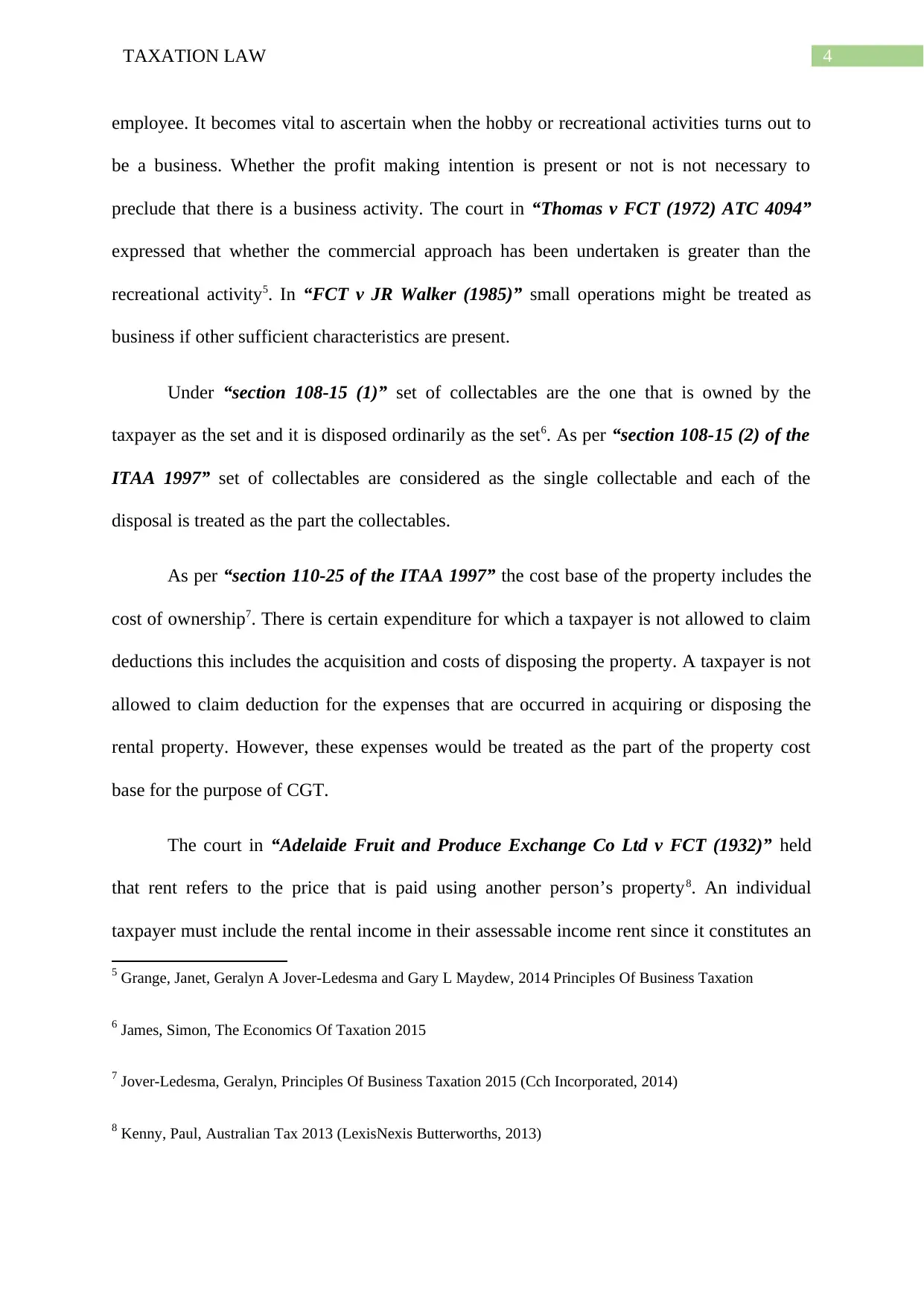
4TAXATION LAW
employee. It becomes vital to ascertain when the hobby or recreational activities turns out to
be a business. Whether the profit making intention is present or not is not necessary to
preclude that there is a business activity. The court in “Thomas v FCT (1972) ATC 4094”
expressed that whether the commercial approach has been undertaken is greater than the
recreational activity5. In “FCT v JR Walker (1985)” small operations might be treated as
business if other sufficient characteristics are present.
Under “section 108-15 (1)” set of collectables are the one that is owned by the
taxpayer as the set and it is disposed ordinarily as the set6. As per “section 108-15 (2) of the
ITAA 1997” set of collectables are considered as the single collectable and each of the
disposal is treated as the part the collectables.
As per “section 110-25 of the ITAA 1997” the cost base of the property includes the
cost of ownership7. There is certain expenditure for which a taxpayer is not allowed to claim
deductions this includes the acquisition and costs of disposing the property. A taxpayer is not
allowed to claim deduction for the expenses that are occurred in acquiring or disposing the
rental property. However, these expenses would be treated as the part of the property cost
base for the purpose of CGT.
The court in “Adelaide Fruit and Produce Exchange Co Ltd v FCT (1932)” held
that rent refers to the price that is paid using another person’s property8. An individual
taxpayer must include the rental income in their assessable income rent since it constitutes an
5 Grange, Janet, Geralyn A Jover-Ledesma and Gary L Maydew, 2014 Principles Of Business Taxation
6 James, Simon, The Economics Of Taxation 2015
7 Jover-Ledesma, Geralyn, Principles Of Business Taxation 2015 (Cch Incorporated, 2014)
8 Kenny, Paul, Australian Tax 2013 (LexisNexis Butterworths, 2013)
employee. It becomes vital to ascertain when the hobby or recreational activities turns out to
be a business. Whether the profit making intention is present or not is not necessary to
preclude that there is a business activity. The court in “Thomas v FCT (1972) ATC 4094”
expressed that whether the commercial approach has been undertaken is greater than the
recreational activity5. In “FCT v JR Walker (1985)” small operations might be treated as
business if other sufficient characteristics are present.
Under “section 108-15 (1)” set of collectables are the one that is owned by the
taxpayer as the set and it is disposed ordinarily as the set6. As per “section 108-15 (2) of the
ITAA 1997” set of collectables are considered as the single collectable and each of the
disposal is treated as the part the collectables.
As per “section 110-25 of the ITAA 1997” the cost base of the property includes the
cost of ownership7. There is certain expenditure for which a taxpayer is not allowed to claim
deductions this includes the acquisition and costs of disposing the property. A taxpayer is not
allowed to claim deduction for the expenses that are occurred in acquiring or disposing the
rental property. However, these expenses would be treated as the part of the property cost
base for the purpose of CGT.
The court in “Adelaide Fruit and Produce Exchange Co Ltd v FCT (1932)” held
that rent refers to the price that is paid using another person’s property8. An individual
taxpayer must include the rental income in their assessable income rent since it constitutes an
5 Grange, Janet, Geralyn A Jover-Ledesma and Gary L Maydew, 2014 Principles Of Business Taxation
6 James, Simon, The Economics Of Taxation 2015
7 Jover-Ledesma, Geralyn, Principles Of Business Taxation 2015 (Cch Incorporated, 2014)
8 Kenny, Paul, Australian Tax 2013 (LexisNexis Butterworths, 2013)
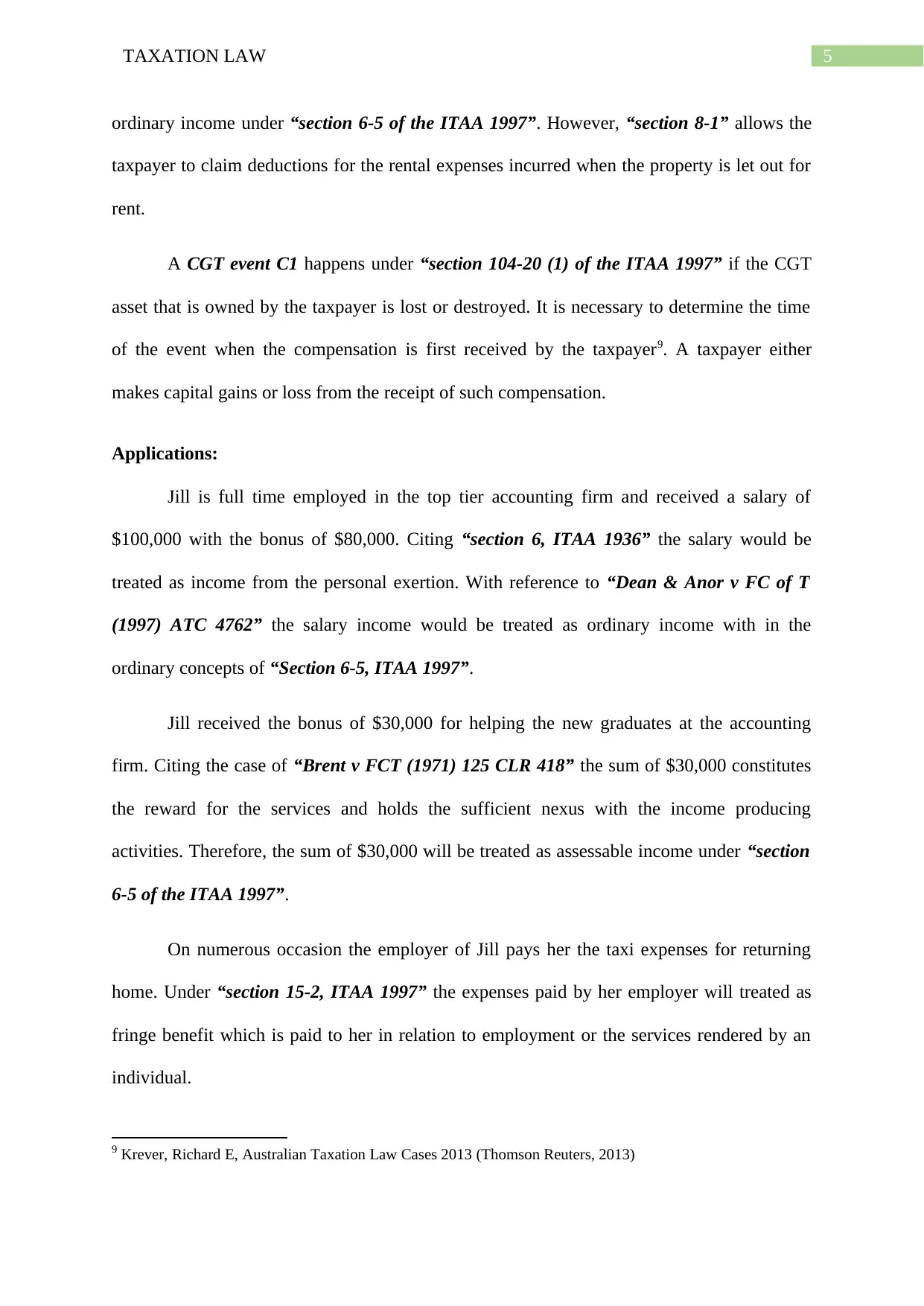
5TAXATION LAW
ordinary income under “section 6-5 of the ITAA 1997”. However, “section 8-1” allows the
taxpayer to claim deductions for the rental expenses incurred when the property is let out for
rent.
A CGT event C1 happens under “section 104-20 (1) of the ITAA 1997” if the CGT
asset that is owned by the taxpayer is lost or destroyed. It is necessary to determine the time
of the event when the compensation is first received by the taxpayer9. A taxpayer either
makes capital gains or loss from the receipt of such compensation.
Applications:
Jill is full time employed in the top tier accounting firm and received a salary of
$100,000 with the bonus of $80,000. Citing “section 6, ITAA 1936” the salary would be
treated as income from the personal exertion. With reference to “Dean & Anor v FC of T
(1997) ATC 4762” the salary income would be treated as ordinary income with in the
ordinary concepts of “Section 6-5, ITAA 1997”.
Jill received the bonus of $30,000 for helping the new graduates at the accounting
firm. Citing the case of “Brent v FCT (1971) 125 CLR 418” the sum of $30,000 constitutes
the reward for the services and holds the sufficient nexus with the income producing
activities. Therefore, the sum of $30,000 will be treated as assessable income under “section
6-5 of the ITAA 1997”.
On numerous occasion the employer of Jill pays her the taxi expenses for returning
home. Under “section 15-2, ITAA 1997” the expenses paid by her employer will treated as
fringe benefit which is paid to her in relation to employment or the services rendered by an
individual.
9 Krever, Richard E, Australian Taxation Law Cases 2013 (Thomson Reuters, 2013)
ordinary income under “section 6-5 of the ITAA 1997”. However, “section 8-1” allows the
taxpayer to claim deductions for the rental expenses incurred when the property is let out for
rent.
A CGT event C1 happens under “section 104-20 (1) of the ITAA 1997” if the CGT
asset that is owned by the taxpayer is lost or destroyed. It is necessary to determine the time
of the event when the compensation is first received by the taxpayer9. A taxpayer either
makes capital gains or loss from the receipt of such compensation.
Applications:
Jill is full time employed in the top tier accounting firm and received a salary of
$100,000 with the bonus of $80,000. Citing “section 6, ITAA 1936” the salary would be
treated as income from the personal exertion. With reference to “Dean & Anor v FC of T
(1997) ATC 4762” the salary income would be treated as ordinary income with in the
ordinary concepts of “Section 6-5, ITAA 1997”.
Jill received the bonus of $30,000 for helping the new graduates at the accounting
firm. Citing the case of “Brent v FCT (1971) 125 CLR 418” the sum of $30,000 constitutes
the reward for the services and holds the sufficient nexus with the income producing
activities. Therefore, the sum of $30,000 will be treated as assessable income under “section
6-5 of the ITAA 1997”.
On numerous occasion the employer of Jill pays her the taxi expenses for returning
home. Under “section 15-2, ITAA 1997” the expenses paid by her employer will treated as
fringe benefit which is paid to her in relation to employment or the services rendered by an
individual.
9 Krever, Richard E, Australian Taxation Law Cases 2013 (Thomson Reuters, 2013)
⊘ This is a preview!⊘
Do you want full access?
Subscribe today to unlock all pages.

Trusted by 1+ million students worldwide
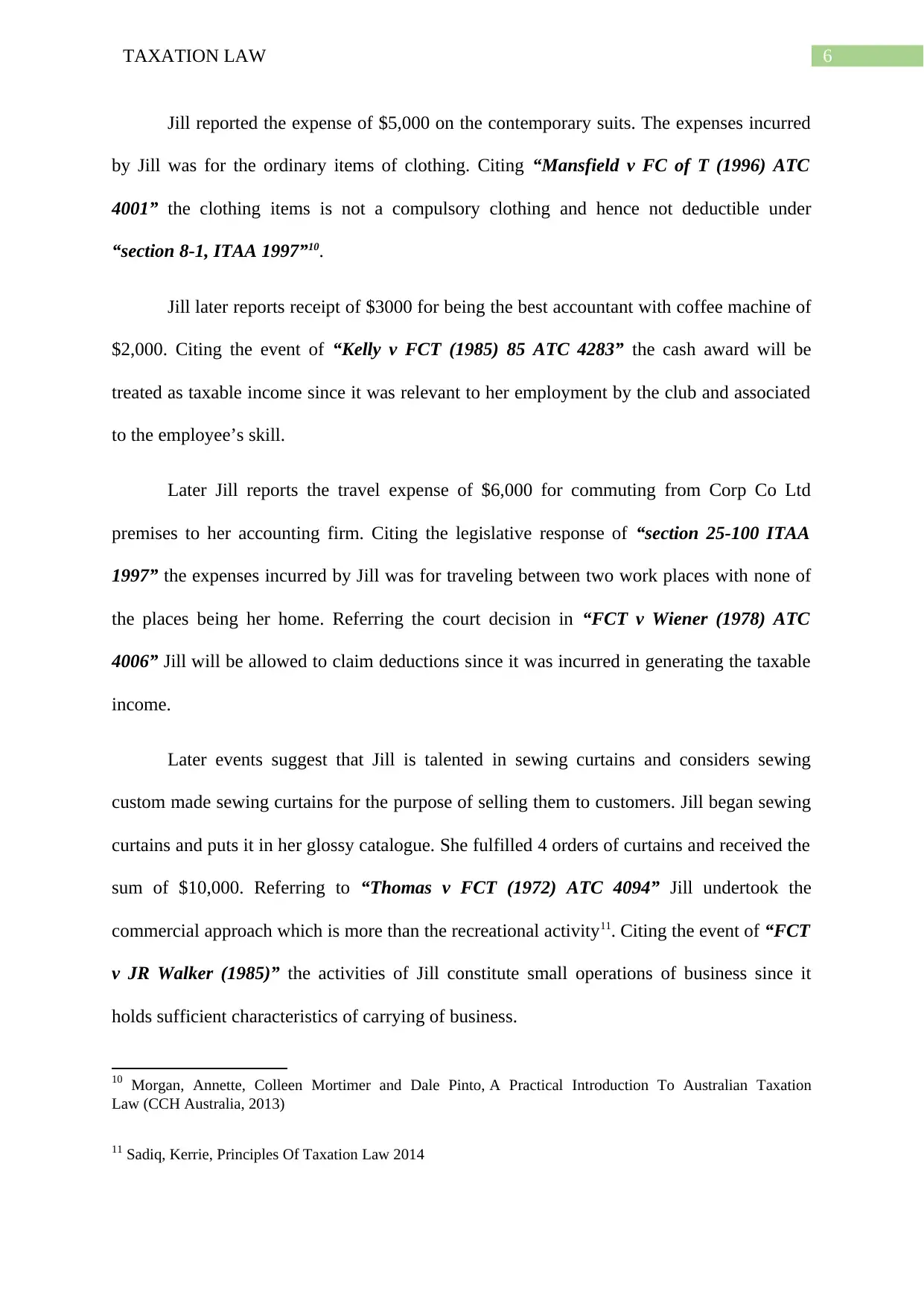
6TAXATION LAW
Jill reported the expense of $5,000 on the contemporary suits. The expenses incurred
by Jill was for the ordinary items of clothing. Citing “Mansfield v FC of T (1996) ATC
4001” the clothing items is not a compulsory clothing and hence not deductible under
“section 8-1, ITAA 1997”10.
Jill later reports receipt of $3000 for being the best accountant with coffee machine of
$2,000. Citing the event of “Kelly v FCT (1985) 85 ATC 4283” the cash award will be
treated as taxable income since it was relevant to her employment by the club and associated
to the employee’s skill.
Later Jill reports the travel expense of $6,000 for commuting from Corp Co Ltd
premises to her accounting firm. Citing the legislative response of “section 25-100 ITAA
1997” the expenses incurred by Jill was for traveling between two work places with none of
the places being her home. Referring the court decision in “FCT v Wiener (1978) ATC
4006” Jill will be allowed to claim deductions since it was incurred in generating the taxable
income.
Later events suggest that Jill is talented in sewing curtains and considers sewing
custom made sewing curtains for the purpose of selling them to customers. Jill began sewing
curtains and puts it in her glossy catalogue. She fulfilled 4 orders of curtains and received the
sum of $10,000. Referring to “Thomas v FCT (1972) ATC 4094” Jill undertook the
commercial approach which is more than the recreational activity11. Citing the event of “FCT
v JR Walker (1985)” the activities of Jill constitute small operations of business since it
holds sufficient characteristics of carrying of business.
10 Morgan, Annette, Colleen Mortimer and Dale Pinto, A Practical Introduction To Australian Taxation
Law (CCH Australia, 2013)
11 Sadiq, Kerrie, Principles Of Taxation Law 2014
Jill reported the expense of $5,000 on the contemporary suits. The expenses incurred
by Jill was for the ordinary items of clothing. Citing “Mansfield v FC of T (1996) ATC
4001” the clothing items is not a compulsory clothing and hence not deductible under
“section 8-1, ITAA 1997”10.
Jill later reports receipt of $3000 for being the best accountant with coffee machine of
$2,000. Citing the event of “Kelly v FCT (1985) 85 ATC 4283” the cash award will be
treated as taxable income since it was relevant to her employment by the club and associated
to the employee’s skill.
Later Jill reports the travel expense of $6,000 for commuting from Corp Co Ltd
premises to her accounting firm. Citing the legislative response of “section 25-100 ITAA
1997” the expenses incurred by Jill was for traveling between two work places with none of
the places being her home. Referring the court decision in “FCT v Wiener (1978) ATC
4006” Jill will be allowed to claim deductions since it was incurred in generating the taxable
income.
Later events suggest that Jill is talented in sewing curtains and considers sewing
custom made sewing curtains for the purpose of selling them to customers. Jill began sewing
curtains and puts it in her glossy catalogue. She fulfilled 4 orders of curtains and received the
sum of $10,000. Referring to “Thomas v FCT (1972) ATC 4094” Jill undertook the
commercial approach which is more than the recreational activity11. Citing the event of “FCT
v JR Walker (1985)” the activities of Jill constitute small operations of business since it
holds sufficient characteristics of carrying of business.
10 Morgan, Annette, Colleen Mortimer and Dale Pinto, A Practical Introduction To Australian Taxation
Law (CCH Australia, 2013)
11 Sadiq, Kerrie, Principles Of Taxation Law 2014
Paraphrase This Document
Need a fresh take? Get an instant paraphrase of this document with our AI Paraphraser
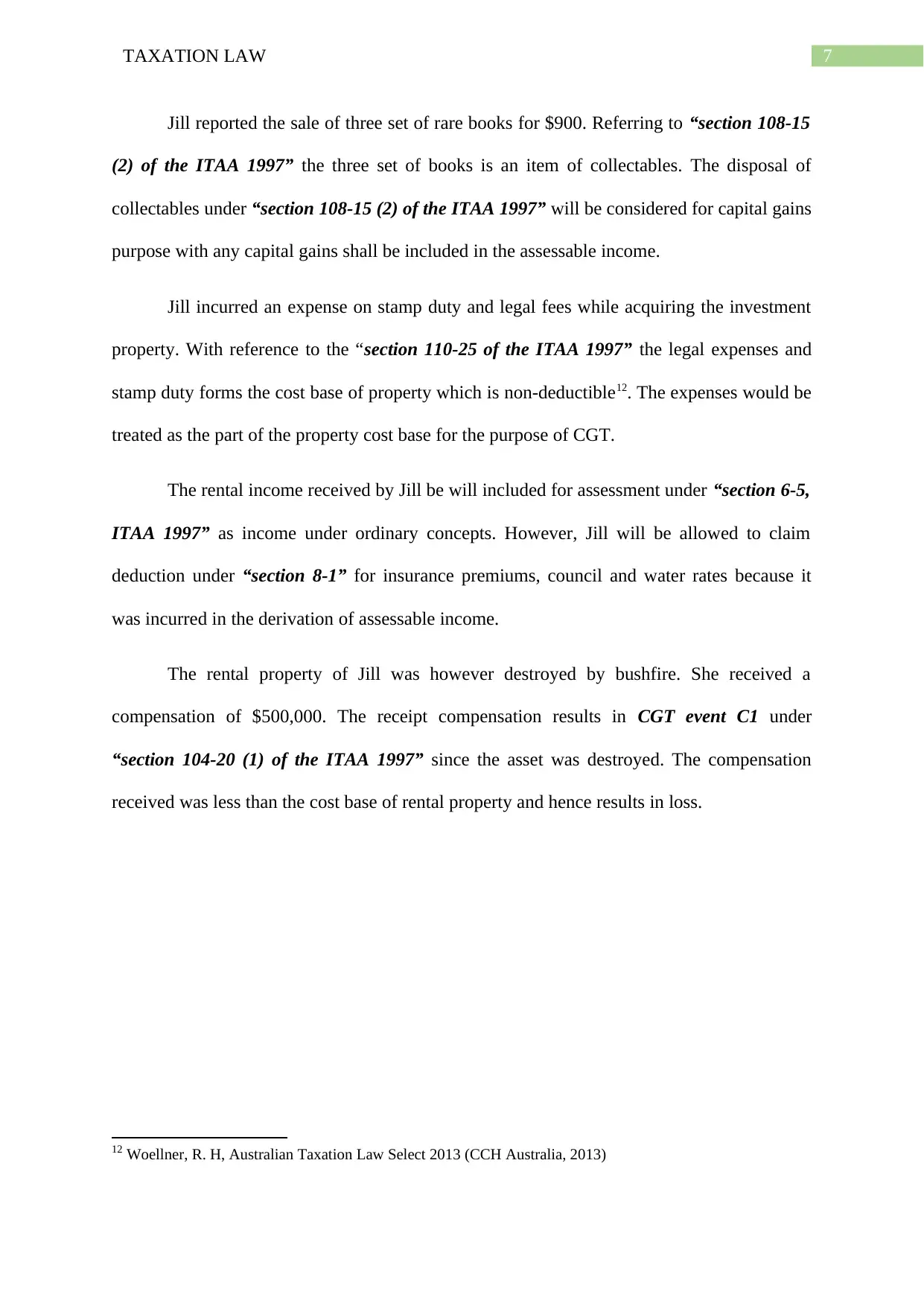
7TAXATION LAW
Jill reported the sale of three set of rare books for $900. Referring to “section 108-15
(2) of the ITAA 1997” the three set of books is an item of collectables. The disposal of
collectables under “section 108-15 (2) of the ITAA 1997” will be considered for capital gains
purpose with any capital gains shall be included in the assessable income.
Jill incurred an expense on stamp duty and legal fees while acquiring the investment
property. With reference to the “section 110-25 of the ITAA 1997” the legal expenses and
stamp duty forms the cost base of property which is non-deductible12. The expenses would be
treated as the part of the property cost base for the purpose of CGT.
The rental income received by Jill be will included for assessment under “section 6-5,
ITAA 1997” as income under ordinary concepts. However, Jill will be allowed to claim
deduction under “section 8-1” for insurance premiums, council and water rates because it
was incurred in the derivation of assessable income.
The rental property of Jill was however destroyed by bushfire. She received a
compensation of $500,000. The receipt compensation results in CGT event C1 under
“section 104-20 (1) of the ITAA 1997” since the asset was destroyed. The compensation
received was less than the cost base of rental property and hence results in loss.
12 Woellner, R. H, Australian Taxation Law Select 2013 (CCH Australia, 2013)
Jill reported the sale of three set of rare books for $900. Referring to “section 108-15
(2) of the ITAA 1997” the three set of books is an item of collectables. The disposal of
collectables under “section 108-15 (2) of the ITAA 1997” will be considered for capital gains
purpose with any capital gains shall be included in the assessable income.
Jill incurred an expense on stamp duty and legal fees while acquiring the investment
property. With reference to the “section 110-25 of the ITAA 1997” the legal expenses and
stamp duty forms the cost base of property which is non-deductible12. The expenses would be
treated as the part of the property cost base for the purpose of CGT.
The rental income received by Jill be will included for assessment under “section 6-5,
ITAA 1997” as income under ordinary concepts. However, Jill will be allowed to claim
deduction under “section 8-1” for insurance premiums, council and water rates because it
was incurred in the derivation of assessable income.
The rental property of Jill was however destroyed by bushfire. She received a
compensation of $500,000. The receipt compensation results in CGT event C1 under
“section 104-20 (1) of the ITAA 1997” since the asset was destroyed. The compensation
received was less than the cost base of rental property and hence results in loss.
12 Woellner, R. H, Australian Taxation Law Select 2013 (CCH Australia, 2013)
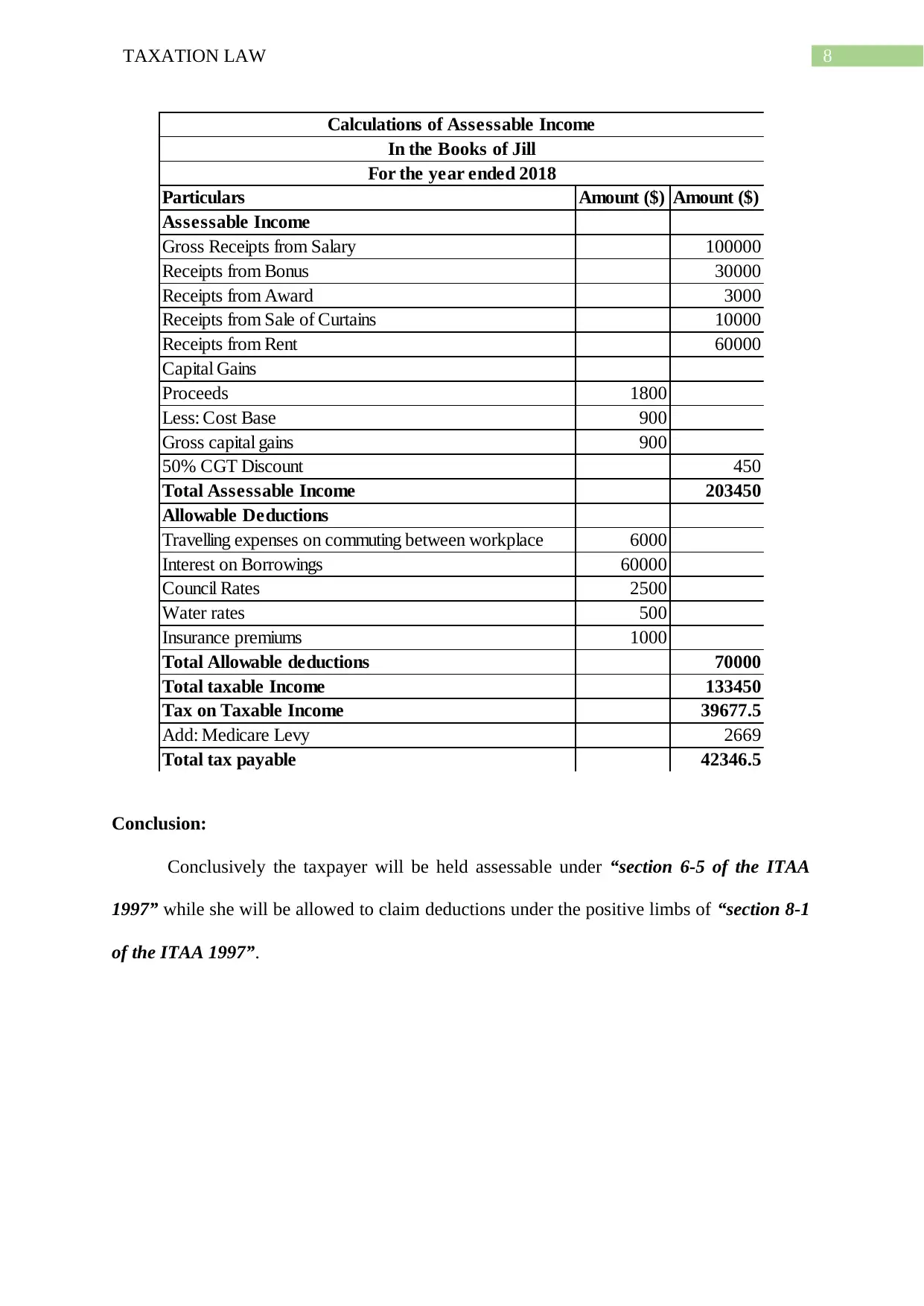
8TAXATION LAW
Particulars Amount ($) Amount ($)
Assessable Income
Gross Receipts from Salary 100000
Receipts from Bonus 30000
Receipts from Award 3000
Receipts from Sale of Curtains 10000
Receipts from Rent 60000
Capital Gains
Proceeds 1800
Less: Cost Base 900
Gross capital gains 900
50% CGT Discount 450
Total Assessable Income 203450
Allowable Deductions
Travelling expenses on commuting between workplace 6000
Interest on Borrowings 60000
Council Rates 2500
Water rates 500
Insurance premiums 1000
Total Allowable deductions 70000
Total taxable Income 133450
Tax on Taxable Income 39677.5
Add: Medicare Levy 2669
Total tax payable 42346.5
Calculations of Assessable Income
In the Books of Jill
For the year ended 2018
Conclusion:
Conclusively the taxpayer will be held assessable under “section 6-5 of the ITAA
1997” while she will be allowed to claim deductions under the positive limbs of “section 8-1
of the ITAA 1997”.
Particulars Amount ($) Amount ($)
Assessable Income
Gross Receipts from Salary 100000
Receipts from Bonus 30000
Receipts from Award 3000
Receipts from Sale of Curtains 10000
Receipts from Rent 60000
Capital Gains
Proceeds 1800
Less: Cost Base 900
Gross capital gains 900
50% CGT Discount 450
Total Assessable Income 203450
Allowable Deductions
Travelling expenses on commuting between workplace 6000
Interest on Borrowings 60000
Council Rates 2500
Water rates 500
Insurance premiums 1000
Total Allowable deductions 70000
Total taxable Income 133450
Tax on Taxable Income 39677.5
Add: Medicare Levy 2669
Total tax payable 42346.5
Calculations of Assessable Income
In the Books of Jill
For the year ended 2018
Conclusion:
Conclusively the taxpayer will be held assessable under “section 6-5 of the ITAA
1997” while she will be allowed to claim deductions under the positive limbs of “section 8-1
of the ITAA 1997”.
⊘ This is a preview!⊘
Do you want full access?
Subscribe today to unlock all pages.

Trusted by 1+ million students worldwide
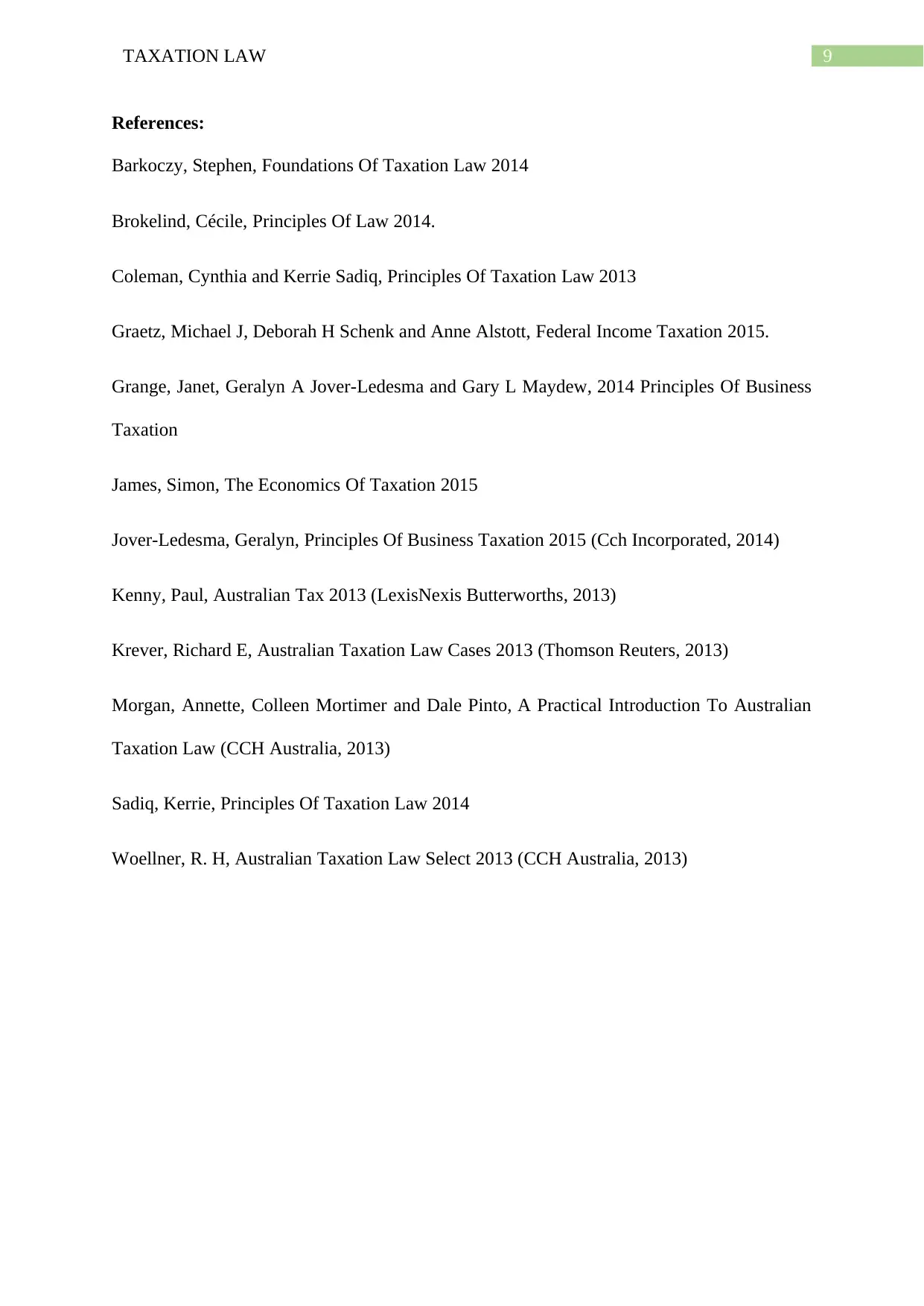
9TAXATION LAW
References:
Barkoczy, Stephen, Foundations Of Taxation Law 2014
Brokelind, Cécile, Principles Of Law 2014.
Coleman, Cynthia and Kerrie Sadiq, Principles Of Taxation Law 2013
Graetz, Michael J, Deborah H Schenk and Anne Alstott, Federal Income Taxation 2015.
Grange, Janet, Geralyn A Jover-Ledesma and Gary L Maydew, 2014 Principles Of Business
Taxation
James, Simon, The Economics Of Taxation 2015
Jover-Ledesma, Geralyn, Principles Of Business Taxation 2015 (Cch Incorporated, 2014)
Kenny, Paul, Australian Tax 2013 (LexisNexis Butterworths, 2013)
Krever, Richard E, Australian Taxation Law Cases 2013 (Thomson Reuters, 2013)
Morgan, Annette, Colleen Mortimer and Dale Pinto, A Practical Introduction To Australian
Taxation Law (CCH Australia, 2013)
Sadiq, Kerrie, Principles Of Taxation Law 2014
Woellner, R. H, Australian Taxation Law Select 2013 (CCH Australia, 2013)
References:
Barkoczy, Stephen, Foundations Of Taxation Law 2014
Brokelind, Cécile, Principles Of Law 2014.
Coleman, Cynthia and Kerrie Sadiq, Principles Of Taxation Law 2013
Graetz, Michael J, Deborah H Schenk and Anne Alstott, Federal Income Taxation 2015.
Grange, Janet, Geralyn A Jover-Ledesma and Gary L Maydew, 2014 Principles Of Business
Taxation
James, Simon, The Economics Of Taxation 2015
Jover-Ledesma, Geralyn, Principles Of Business Taxation 2015 (Cch Incorporated, 2014)
Kenny, Paul, Australian Tax 2013 (LexisNexis Butterworths, 2013)
Krever, Richard E, Australian Taxation Law Cases 2013 (Thomson Reuters, 2013)
Morgan, Annette, Colleen Mortimer and Dale Pinto, A Practical Introduction To Australian
Taxation Law (CCH Australia, 2013)
Sadiq, Kerrie, Principles Of Taxation Law 2014
Woellner, R. H, Australian Taxation Law Select 2013 (CCH Australia, 2013)
1 out of 10
Related Documents
Your All-in-One AI-Powered Toolkit for Academic Success.
+13062052269
info@desklib.com
Available 24*7 on WhatsApp / Email
![[object Object]](/_next/static/media/star-bottom.7253800d.svg)
Unlock your academic potential
Copyright © 2020–2025 A2Z Services. All Rights Reserved. Developed and managed by ZUCOL.





